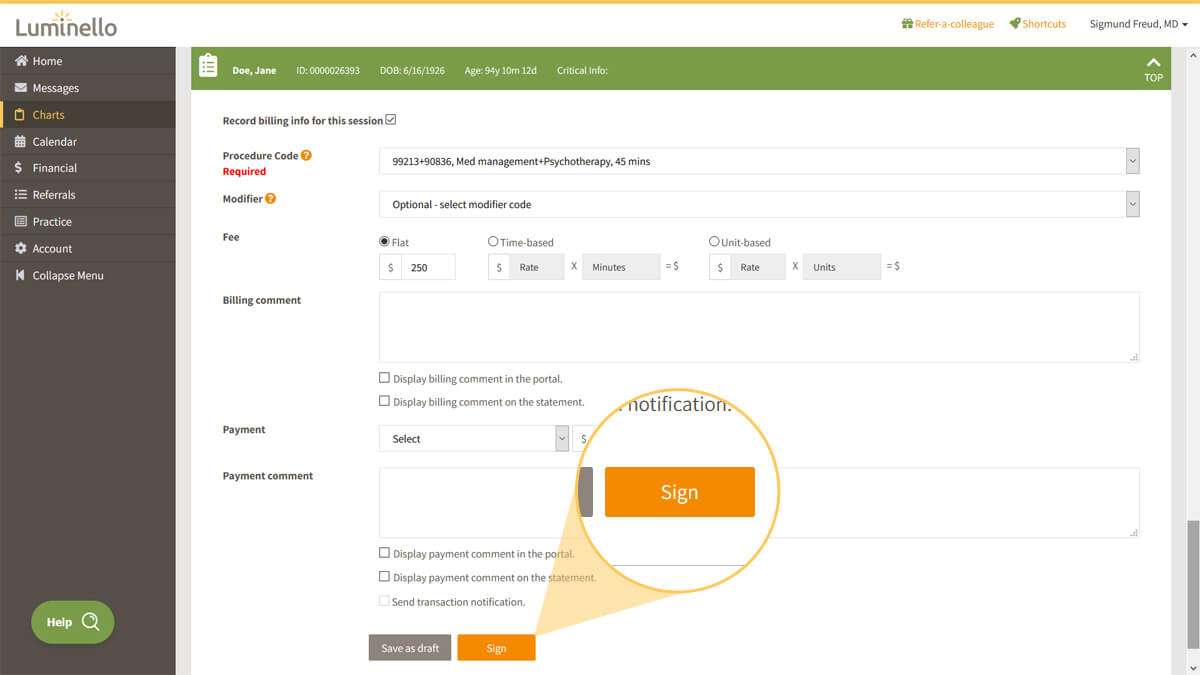If you’re among the thousands of therapy practices that want to go paperless or replace clinical software, you’ve come to the right place. It can be daunting to sort through the many electronic health record (EHR) systems out there for mental and behavioral health care providers. What’s more, pricing and functionality varies greatly from system to system.
This guide will help you better understand the therapy software market. Using it, you can narrow down your list of potential products for an upcoming purchase.
We’ll discuss the following:
What Is Therapy Software?
Common Functionality of Therapy Software
Market Trends to Understand
What Is Therapy Software?
The term “therapy software” applies to any software that helps therapists deliver better care, manage their practice or process their billing. These systems offer a range of tools that facilitate everything from clinical documentation to scheduling and insurance claims submission.
Therapy software vendors may sell a single application, such as therapy notes, as a stand-alone solution. Alternatively, they may offer a number of applications bundled together to form an integrated EHR suite for therapists.

The breadth and depth of applications in the system you choose will depend on your needs, user base and budget. This is especially true in therapy practices, which come in all manner of sizes and specialties employing social workers, therapists, counselors, psychiatrists and/or psychologists:

If you’re a smaller therapy provider and/or outsource your medical billing, it might be more cost-effective to seek stand-alone applications to fill specific gaps in health information technology. For example, if your only goal with a new system is to digitize your staff’s clinical notes, buying a stand-alone clinical documentation system makes more sense than a full EHR. Otherwise, you may end up paying for functions you don’t need, such as e-prescribing or patient portals.
Since larger therapy providers tend to have a larger number of users and require a greater level of care coordination, integrated therapy EHR suites are often the more practical choice. With several different functions packaged together, it’s easier to extract meaningful health outcomes data while tracking clinical and budgetary goals.
Common Functionality of Therapy Software
As we explained above, the tools provided in therapist software products may vary. Here are some of the most common ones, which may be sold as stand-alone applications or as part of integrated suites:
Clinical documentation Therapists can create, store and review a number of digital clinical documents for each patient’s records. These include intake notes, progress notes, treatment plans, medical histories and more. Electronic claim filing Users can file claims electronically through the system, then track progress to see which claims have been submitted, accepted and approved. Appointment scheduling Allows users to schedule single or recurring appointments in a digital calendar. Some systems let you track cancellations and no-shows or send automated therapy appointment reminders to your patients through email, text or phone. Billing Most solutions allow for a number of different billing functions. These include generating patient invoices, statements and superbills. The software can also produce single or batch CMS-1500s and/or billing reports. Coding When filling out clinical documentation, most systems allow users to select the appropriate DSM-5 and/or ICD-10 codes from a pre-populated menu for faster, more accurate coding.
Market Trends to Understand
Once you’ve identified your organization’s must-have software functions and are ready to start considering specific vendors, it’s important to consider these market trends:
HIPAA compliance. The government’s privacy and security laws—the Health Insurance Portability and Accountability Act (HIPAA) and the Health Information Technology for Economic and Clinical Health (HITECH) Act—help safeguard patient data, and they carry steep penalties if violated. Reputable vendors will make sure you understand how and why their products can help you achieve HIPAA compliance by explaining data protection and encryption capabilities.
Cloud-based systems. One of the first choices you’ll have to make when selecting new software is whether to pick a cloud-based or an on-premise system.
Cloud-based systems are becoming increasingly common in the therapy software market, as they bring a number of benefits:
- Remote accessibility
- Lower upfront costs
- Software updates handled by vendor
- System maintenance handled by vendor
It’s important to note, however, that therapy practices in rural settings may have a hard time accessing the broadband Internet that’s required to run a Web-based system.
To mental and behavioral health care providers, therapy notes are essential for documenting patient encounters. What’s more, therapy notes are consistently cited as a top-requested electronic health records (EHR) software functionality by buyers who contact Software Advice.
There are hundreds of solutions that offer therapy notes for practitioners looking to make a first-time or replacement purchase. To help you narrow down your options and better understand what’s available in today’s market, we put together this buyer’s guide.
Here’s what we’ll cover:
What Is Therapy Notes Software?
Common Functionality of Therapy Notes Software
Benefits of Electronic Therapy Notes
Deployment Strategies and Pricing
Market Trends To Understand
What Is Therapy Notes Software?
“Therapy notes” can refer to several different kinds of medical forms that are needed to document patient encounters in mental and behavioral health care settings.
These can include:

These types of mental health progress notes are essential for practitioners to record patient assessments, treatments and results over time. The data can also be used for tracking and coordinating care to achieve healthy outcomes. And in some cases, these notes serve as the official record of the patient relationship and may be subpoenaed in court.
In light of all this, it’s extremely important for therapy notes to be as comprehensive, up-to-date and secure as possible. Indeed, the right software ensures notes are legible and automatically marked with time and date stamps. Drop-down menus and templates make it easy for practitioners to enter detailed patient observations. Plus, electronic files are generally more secure than paper-based records.
Common Functionality of Therapy Notes Software
Specialty-specific notes templates Most systems should offer notes templates for a range of specialties, such as psychotherapy, psychiatry and behavioral health. Some allow users to customize templates with additional fields/terminology. Templates usually offer drop-down menus and click-boxes. Note management Allows users to easily view/retrieve notes and assessments, in order for human services specialists to access old notes and review previous sessions. Outcomes tracking Allows users to turn therapy notes data into reports, for gauging health outcomes across patient populations. (Measuring care outcomes is recommended by the Diagnostic and Statistical Manual of Mental Disorders, Fifth Edition [DSM-5].) Coding tools Help users select and enter codes in note templates and billing modules from a pre-programmed menu or searchable database. These clinical documentation codes may include CPT, ICD and/or DSM codes. Staff management Users are assigned roles within the system (e.g., site administrators, clinicians or billers) that provide different levels of access (e.g., clinicians can only see the notes for their own patients). Supervisors can receive missing notes reports and notifications for notes that need approval. Standard functionality for systems aimed at larger organizations.
Benefits of Electronic Therapy Notes
Some of the benefits of electronic therapy notes should already be clear from our discussion, but here’s a complete listing:
- No double-entry. When you enter data electronically, you don’t need to bother with digitizing it down the road.
- Paperless office. By using electronic therapy notes, you’re one step closer to achieving the ecological nirvana (and the cost-savings) of a paperless office.
- Improved organization. Electronic therapy notes are automatically organized by time/date and patient – no hunting through file-cabinets.
- Patient analytics. As we’ve seen, electronic therapy notes can feed historical reports that track patient progress over time. Do you really plan to turn all your old paper notes into charts?
- Easier coding. ICD 10 codes are a pain, and we all know the DSM V tends to make coding more painful rather than less. Thankfully, these tools offer features to assist with the tedious task of coding.
Deployment Strategies and Pricing
Stand-alone or “best-of-breed” programs can be implemented to create, edit and store different kinds of therapy notes. Vendors of this type of software often offer tiered pricing plans.
For example, at the first, most basic tier, buyers might pay a monthly fee allowing a small pool of users access to basic functionality and services, such as progress notes templates, document storage and limited email support from the vendor.
At the higher-priced tiers, buyers might be able to add more users to the system and/or to access more advanced functionality or services beyond what the lower tiers provide. These additional capabilities might include reporting and analytics, electronic claims submissions or live phone support from the vendor.
Buyers seeking a more comprehensive deployment strategy can implement a therapy software suite that includes other capabilities in addition to therapy notes. For example, an EHR suite may also offer billing, patient scheduling and human resources applications. Pricing for these suites can be much more expensive, as they offer a greater breadth of both clinical and practice management functionalities.
Your choice between a best-of-breed system or integrated suite will come down to the size of your practice, your budget and whether you want your solution to integrate with other software.
Market Trends to Understand
You will likely come across some of the following market trends as you begin your search for therapy notes software:
Cloud-based deployment. One of the most important choices buyers need to consider is whether they’d like a cloud-based or an on-premise solution. The cloud model provides Software-as-a-Service (SaaS), in which the system is hosted on external servers and accessed remotely through the Web. In on-premise systems, the software is hosted on the practice’s own servers and must be updated and maintained locally.
Cloud-based EMR mental health systems are becoming increasingly popular. Not only do they offer the flexibility of remote access, they also involve lower upfront costs, and updates and maintenance are handled by the vendor.
Mobile device support. Support for wireless devices, such as smartphones and tablets, is becoming common among mental and behavioral health software vendors. The convenience and portability of such devices makes them ideal for reviewing progress notes and managing scheduling changes on the go. Some vendors are even introducing HIPAA-compliant native applications for Windows, Android and/or iOS devices. What’s more, a report conducted by Software Advice finds that mobile users cite higher levels of satisfaction and fewer challenges with their EHR than non-mobile users.




